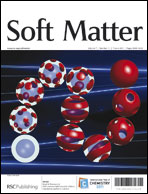Packing correlations, collective scattering and compressibility of fractal-like aggregates in polymer nanocomposites and suspensions
Abstract
We employ a small scale Monte Carlo method plus microscopic liquid state integral equation theory to study two models of fractal-like aggregates (single and quenched disordered averaged) as a function of concentration. The models employed are relevant to non-compact carbon black or


 Please wait while we load your content...
Please wait while we load your content...